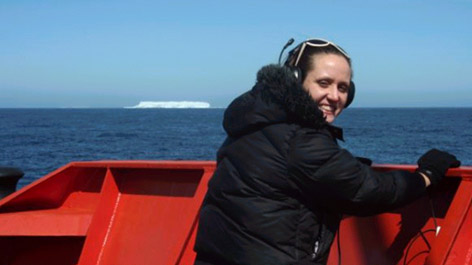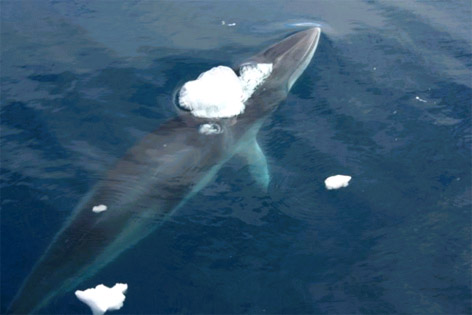 |
| Julia O’Hern listening and recording underwater sounds at the bow of the ship |
On the way back we have passed west of the Orkney Islands. The ocean here is scabbed over with ice and full of life. From midnight until 8 am I am responsible for taking water samples for analysis of halogenated carbons. During the day, I conduct acoustic listening stations during CTD casts. At these stations I use a small over-the-side hydrophone and recorder to listen to the water for the sounds of nearby whales. Since whales spend over 80% of their lives below the surface, it is often easier to detect their presence acoustically, rather than visually. As part of my PhD research I collect satellite data on mesoscale oceanographic features and correlate these with whale presence and behavior. Using the density profiles recorded by our CTD, I will be able to calculate the speed of sound at each of our stations and estimate the distance between our ship and recorded whales.
 |
| To the west of the Orkney Islands we have found the ocean scabbed over with ice and full of life. It is a sunny day, and the sea is like a mirror. A perfect day! |
 |
| A close view of the minke whale spotted this morning |
Each morning after my watch I try to catch a few hours of sleep, but this morning when my professor knocked on my cabin door to tell me that there was a whale outside, I jumped up out of my sleep and nearly fell to the floor from my top bunk. Two minke whales (Rorcual Aliblanco) (Balaenoptera acutorostrata) were circling our ship and ducking under the blue chunks of ice. Minke whales are baleen whales. This kind of whale has no teeth. Instead they have long, course plates in their mouths that they use for straining water from clumps of plankton and fish. Minkes are the smallest of the baleen whales measuring just 25-30 feet (7.8-9m) long, and weighing about 6-7.5 tons (5.4-6.8tons). Today, minkes are the most abundant of the baleen whales and still hunted worldwide. They produce very loud sounds, but at frequencies about 10 times lower than those at which humans communicate. We cannot be sure what kind of effect engine noise, sonar blasts and other human produced noise pollution has on minkes and other whales. The various frequencies at which these sounds are produced likely impact many different species and may make it impossible for whales to communicate with each other or navigate through the great blue distances they regularly travel in search of food and mates. Many whales seem to avoid human activity, while others like the whales that visited us, seem curious. These whales spent over half an hour weaving themselves beneath our hull and around the bow of our ship. Just before blowing one last blast of icy air above the surface of the water, one of the whales rolled onto her side and peered up at us, then sank back seamlessly into the water and disappeared from sight.
Local time: 14.00 h (16.00 GMT)
Location: latitude: 60º 40’ 13’’ S; longitude: 45º 46’ 51’’ W
Wind: 1 m/s
Air temperature: 2.1ºC
Surface water temperature: 0.1ºC